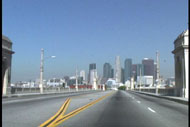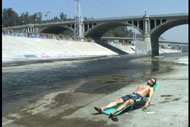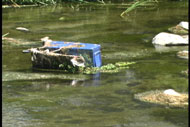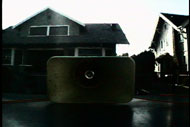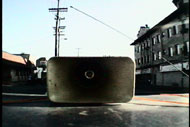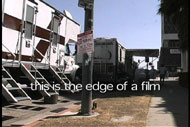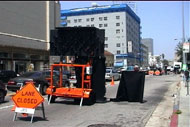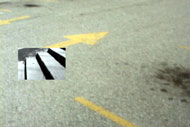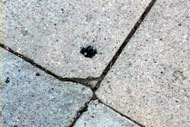 |
July
2002 volume 1, issue 1 |
| |
|
|
|
Interview with A-Clip Christina Ulke talked with Katja Eydel and Klaus Weber about the origin of A-clip, which came out of a moment in Berlin when artists, activists and intellectuals were consciously collaborating. Christina Ulke: Could you talk a little about the historical context of A-clip? Klaus Weber: Aclip started in 1996. In 1996, especially in Berlin, there was a trend to make collaborative work and to see the production of culture as a political option. We were part of a group who organized a counter fair called Minus 96. It took place at the Ahornblatt on Leipziger Street, a very beautiful GDR building in the form of a leaf, a wonderful example of concrete architecture. Katja Eydel: The building was a historical landmark but the city government wanted to tear it down. A part of our plan was to create a public for the building, which tied into the theme of the fair. The idea for the fair came up when people in different fields realized that they were working on the same issue, the issue of gentrification. We somehow tried to build up a network around this issue. Christina Ulke: What sorts of groups were involved? Klaus Weber: A group of artists with strong connections to local activists… Katja Eydel: …and theoretical people, Diederichsen and such. Once the project was publicized, activist groups got involved as well. Klaus Weber: … groups like ARI — anti-racist initiative. They organized food and actions. Katja Eydel: 15 to 20 people organized the fair, 40-50 people presented. Within the 2 days of the conference maybe 200-300 people showed up. Katja Eydel: The model of the fair was taken from an event that took place in Cologne 1995, Messe 2 ok. Klaus Weber: Messe 2 ok was organized explicitly in opposition to the Art Fair Cologne. It aimed towards the art world. This was a point on which the artists of Minus 96 split; some wanted to connect to the art scene, others wanted to be more politically engaged. Katja Eydel: The question of context, the question of audience, these were the dividing lines. Christina Ulke: The ones who decided against an art audience — who did they want to address? Katja Eydel: Just the public, a broader public. Christina Ulke: What happened at the fair? Klaus Weber: We had regular meetings. Lots of different people presented projects; works, actions. I presented the idea of A-clip— to bring short critical clips into mainstream movie theatres, to create what I call "an urban political window" in a commercial context. Katja Eydel: I really liked the first meetings; it was funky - the way of speaking, the seriousness, the exchange of information. The process of learning was very intense and rich. Klaus Weber: This fair really had two meanings; to show and present people’s work around urban issues, to let others know what was going on in the city and to start thinking about organizing a larger campaign. The fair had a city report where we discussed new trends we thought were specific to Berlin. For example the attempt of the city government to develop "inner city districts" - new laws got passed which declared special areas of the city as "dangerous zones" where people could be controlled arbitrarily without reasonable suspicion. Katja Eydel: The dangerous zones were public secrets. We weren’t supposed to know about them but the silly thing was that the Bildzeitung newspaper publicized them. Klaus Weber: When city government wanted to revaluate the city as a corporate entity, they built up two new groups in Berlin, AG City and OG City. OG City is a operative commando troop, a special police unit for the inner city district. AG City means "WorkGroup City", a group of business people of the western inner city district. When AG City complained about too much disruption of their business, too many people hanging around, too many people who steal, too many people who piss, OG City said, "okay, let’s declare this a dangerous zone". The new shift in the public space of Berlin was very tightly connected to commercial issues. Christina Ulke: That happened 1996/7? Klaus Weber: In the middle of the nineties. It had a lot to do with Berlin’s status as a capital city and with the reconstruction of the Eastern part of the city. Katja Eydel: The whole development in East Berlin was moving along and commercial centers started to compete. All of a sudden there was a city center in the East — Friedrich Straße and so on. The City Center West was afraid of losing business to the new center; it was this same competition, which pushed the new inner city legislation Klaus Weber: The government had a new chance to play with and prove new urban theories. For examples, look at the Potsdamer Platz. This growth wouldn’t have been possible in other German cities. The Potsdamer Platz was a huge empty expanse in the middle of the city; it was the former wall strip, there was nothing. It was the first time in Germany that private business could build up a city, so they took it all and privatized it. Klaus Weber: Suddenly the surface of the urban structure was a political surface. Urban planning was on everyone’s mind. |
||
|
|
|||
